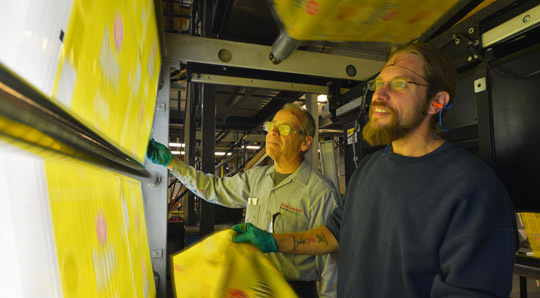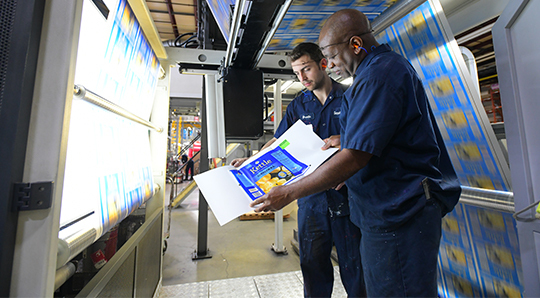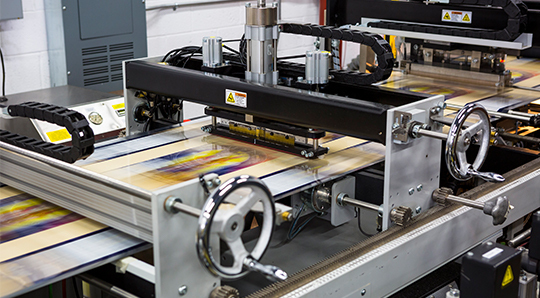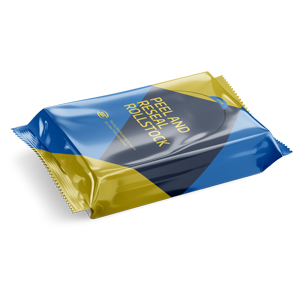It’s simple. You need your packaging when you need it—not a day late, and not a month early—all at an optimized, fair market price. It’s critical that you maintain service to your customers, avoiding empty shelves, lost revenues, or damaged credibility. And, this should all be accomplished without carrying excessive inventories of packaging film.
Here, we’ll explore how you can identify a flexible packaging converter that can help you on both counts: Cutting costs and meeting deadlines.

Addressing supply chain & delivery issues at their source
It’s the role of your packaging supplier to mold their production and delivery timelines around your schedule. Suppliers have several tools they can use to do this, the most important being clear and transparent communication.
Using past data to forecast future demand, they should be able to work with you to design a data-driven supply chain program that eliminates late deliveries. Examples might be:
- A raw material stocking program to shorten finished goods lead times.
- The ability to establish and maintain a min/max program of finished goods or a vendor-managed inventory program on key items.
- A warehousing program for finished goods inventory, providing immediate material availability at predefined levels and a predefined warehouse location.
First, your packaging supplier will ask you to share your forecasted demand for each SKU, including expected seasonal spikes. Do you historically have seasonality to your business? Do you have scheduled promotions that could spike demands?
If, as a simplified example, your packaging supplier knows you sell 50,000 units of a particular SKU each month—except for during the summer, when you sell 100,000 units per month—they can work backwards to build a program that ensures you always have the packaging you need, when you need it.
The best flexible packaging converters will set up an agreement with their raw materials suppliers to make sure there are always enough raw materials to manufacture your packaging. And they’ll book capacity on their machines well in advance of your deadlines so all your packaging is converted and delivered on time.
Examples of tools that a packaging supplier may use to ensure a robust supply chain include:
- Raw material stocking programs – Working with you to understand overall demand (peak/non-peak), the packaging supplier agrees to carry defined raw materials to shorten your packaging lead times.
- Min/max stocking programs – The supplier agrees to establish inventory levels of specific SKUs at defined minimum and maximum levels, resulting in constant on-hand packaging inventory.
- Vendor managed inventory (VMI) programs – You provide a rolling forecast for specific SKUs and the supplier manages production of finished goods against the forecast, resulting in a constant stream of on-hand packaging inventory.
- Make and ship programs – This program is more “transactional” and is essentially supplying packaging material against stated lead times.
Questions to ask potential flexible packaging suppliers:
- Do you offer real-time status reports on packaging orders? What type of interim communication do you provide from when an order is placed until it arrives at my facility?
- How many internal and external warehouse facilities do you have? Where are they?
- What arrangements do you have with your raw material suppliers?
- What information do you require from me to create a VMI program that eliminates late deliveries?
- How many of your facilities can produce my package? To what extent do you offer manufacturing redundancy?
- Can you give me a few examples of how you’ve set up VMI programs for similar-sized brands?
Identifying packaging cost efficiencies
When considering changes in packaging supply, there are two key strategies to consider when evaluating suppliers:
- Audit of your total packaging spend: What do I buy currently?
- Performing a packaging spec review: Is specification data current and accurate?
Evaluating your total packaging spend and order planning strategy
Because there is a certain amount of time and “make-ready” required to set up each converting production job, order size is one of the biggest factors affecting per-package cost. For larger orders, the setup costs are spread out over more packages. The larger your order, the more competitive your pricing.
Instead of placing a 100,000 impression order each month, you’ll command better pricing by placing a 300,000 impression order every three months. And if you were to extrapolate that type of thinking across all of your product lines, you’ll achieve greater economies of scale and significantly reduce your overall packaging costs.
Perform a packaging spec review
Look at your current packaging specifications and ask yourself:
- Are my products over-packaged? Could I save material and production costs by reducing the amount of packaging I use for each of my SKUs?
- Is there an opportunity to consolidate my packaging specs? Say you have 10 SKUs of 10-oz. chips in 10 different packaging formats. If you switched all of these products to one uniform packaging spec, your converter could more efficiently run your packaging orders together, with fewer/quicker graphics changes. This is magnified if your converter has extended-gamut (EG) flexographic presses technologies. This allows your supplier to pass along the savings to you.
Any supplier worth the ink in their flexographic presses should be able to walk you through the above questions—identifying opportunities to streamline packaging specs across your product lines and reducing costs significantly.
Questions to ask potential flexible packaging suppliers:
- If you were tasked with reducing my overall packaging costs, how would you approach this?
- Can you audit how I currently order packaging and identify any potential opportunities for optimization?
- What capabilities do you have (such as extended gamut printing) that could help us reduce packaging costs?
- Are you able to perform a packaging specification audit for all of my product lines?
Let’s eliminate cost and supply chain inefficiencies together
After six decades of manufacturing packaging, we’ve established the expertise and material supplier relationships to overcome any cost or supply chain obstacle. Let’s solve yours together.




